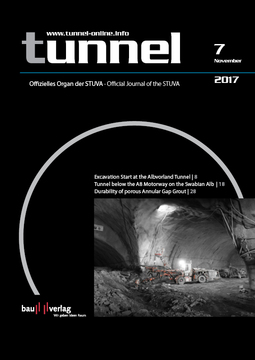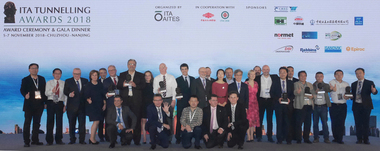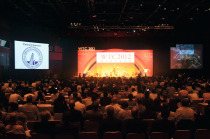Tunnel Market Survey 2016
The International Tunnelling and Underground Space Association (ITA) has been collecting data on international tunnel and underground construction since 2011. A first global market analysis was compiled in 2014. For the second overview, presented at the WTC 2017 in Bergen, the ITA member nations (73 countries) have once again been involved in collecting and checking the data. In total, information from 89 countries and 2300 projects was included in the recent analysis.
This second market analysis clearly shows that the tunnelling market has a considerable size, with a global annual output of 86 billion euros. The market has grown in the past years and will continue to do so. In 2013 the ITA planned with a 5 % annual growth, which in fact exceeded 7 %. According to the ITA forecast this pace will probably continue for the next 5 to 10 years at least.
This growth of around 7 % per year is twice as big as the global construction growth. About 5200 km of tunnels have been constructed annually since 2013, which represents a growth of 15 %. Currently, the tunneling market is representing 6–7 % of the global infrastructure construction market.
China
For the moment and probably the next decade, China will roughly represent 50 % of the global market in terms of output (37 billion euros per year). The development of new large cities will continue. Hence, new metro systems could be built in some 50 more cities at least. Furthermore, the interconnection of urban areas will require the construction of high-speed railway lines (with the necessity to build tunnels) and highways.
India
Compared to 2013, the Indian tunneling market has nearly doubled and is continuing to grow. In India, metros are being built in about 15 cities, and more will follow. Interconnection in this sub-continent is a major challenge. A large-scale infrastructure program needs to be developed. In 2050, Jakarta is expected to be the largest city worldwide, with some 37 million inhabitants. The construction of the first metro line (about 15 km) will have to be followed by many others. Based on comparisons with other mega cities, a metro system of more than 500 km will be required.
East and South East Asia
Japan, South Korea and Singapore are the major tunneling markets while Malaysia is becoming more important with a market of 400 million euros and a growth of 40 % in three years. Another emerging market is Nepal, mainly due to huge hydro projects.
In all South East Asian countries, climate change and an increasing number of storms require the construction of infrastructure to prevent damages. This is planned in Jakarta (Indonesia), but will also be necessary in the Philippines, and probably the storm management program planned in Bangkok will have to be enlarged as well. Vietnam, Cambodia, Myanmar and Bangladesh will require water storage tunnels and storm management infrastructure.
Europe
The European market remains constant at around 10–12 billion euros per year, with Italy, Russia, Turkey, Germany and Austria being the most active countries. In Europe, the development of urban transport will continue, as the objective of cutting the CO2 emissions by half by 2050 has to be achieved. At present the main issue is financing, as the economic growth is smaller compared to other parts of the world.
Middle East
Globally the Middle East region has been the most expanding region with a market growth of around 300 % since the last analysis. This is mainly due to three countries: Iran, Qatar and Saudi Arabia. In Iran, the construction of road and rail tunnels is booming, while Qatar and Saudia Arabia have invested in an extensive metro development.
America
The development of South America is progressing. Large projects are foreseen to cross the Andes, and in the future new high-speed lines will be built in Brazil for sure but also linking cities of neighbouring countries. Generally, the whole region market increased from 2 to 3.6 billion euros.
The development of the North American market is very much dependent on the development of high-speed railway lines. In this continent, where people mainly travel by car or by plane, constraint on energy consumption and a reduction of CO2 emissions could lead to a development in favour of an increased rail traffic.
Africa
Presently the ITA doesn’t see any real projects in Africa, although the need is there. By 2025 Africa will have 20 cities with more than two million inhabitants and three cities with a population of more than ten million. These cities will require new infrastructure (water, sanitation and mass transit), most of which will have to be put underground.





